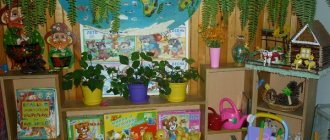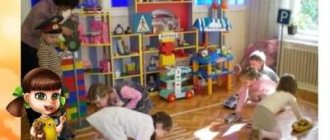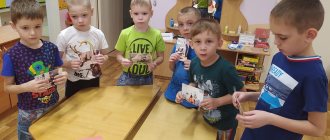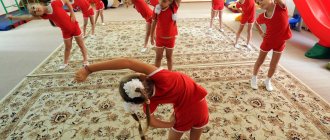MAGAZINE Preschooler.RF
A plan of educational activities in the senior group about the history and attractions of my city. Examination and description of I. Shishkin’s painting “Rye” Types of children’s activities: play, communication, perception of fiction, cognitive and research. Program objectives: • To develop love for one’s hometown and interest in its past and present; • To introduce the history of the name of the city, to cultivate a sense of pride for their fellow countrymen; • Enrich and activate the vocabulary; • Teach verbal description of a painting, instill a love of art and native nature. Planned results: • Can talk about his hometown; • Shows interest in art when looking at photographs and reproductions of I. Shishkin’s painting “Rye”; • Share with the teacher and other children various impressions about your small homeland. Materials and equipment: photographs with views of the city; reproduction of I. Shishkin’s painting “Rye”. Methodical techniques I Introductory part 1.1. Reading of the poem “My Land” by the teacher according to I. Vekshegonova Hello guys, before we start our lesson, I want to read you a poem by Ida Vekshegonova, which is called “My Land”. Listen carefully. “My land is poplar - sometimes fluff, sometimes snow, My beloved city, steep bank. Behind the garden there is a gate, the grass is mush. The path, like a thread, is barely noticeable. She walked through to the village and entered my heart without asking forever.” Ida wrote such a wonderful poem about her land. 1.2. Introductory conversation about the small Motherland Guys, we learned about the Motherland, about the country in which we live, and there is such a concept as “small Motherland”. How do you understand what the concept of “small Motherland” is? (This is our birthplace). Absolutely right, “small Motherland” is the place where you and I were born and live, where we saw the light of the sun and began to explore the world around us. This is the region, the region, the city, the district, the street, the house and our kindergarten that you go to, a small piece of our huge country. Our country is Russia. Children, tell me, what is our city like? (Light, good, clean). Yes, and the city would not be like this if there were not such hardworking people, smart, caring leaders who know what adults need for a good life, what you children need for a fun and carefree life. You are still preschoolers, but when you grow up, you will have to do great, good deeds. In the meantime, you need to love your city, and to love means to know it. 1.3. Finger gymnastics And now guys, let’s stretch our fingers with the help of finger gymnastics “Hello”. Prepare your hands, listen and repeat. “Hello, golden sun! Hello, blue sky! Hello, free breeze, Hello, little oak tree! We live in the same region - I greet you all (with the fingers of the right hand, we “greet” the fingers of the left hand in turn, patting them with the tips).” Well done boys! II Main part 2.1. Message of purpose Children, today we will compose a descriptive story based on the painting “Rye” by Ivan Ivanovich Shishkin. 2.2. Conversation about the work of I.I. Shishkina with the introduction of a portrait Children, pay attention to the board, there is a portrait of I.I. on it. Shishkina. This is a great Russian landscape artist, painter. He was born on January 13, 1832, he grew up as a very gifted boy. Ivan Ivanovich loved nature, it was close to his heart. He dreamed of penetrating the deep secrets of Russian nature. He has paintings “Winter”, “Morning in a Pine Forest”, “Rye”. 2.3. Introducing the painting We will take a closer look at the reproduction of the painting by I.I. Shishkina "Rye". Pay attention to this magnificent picture. 2.4. Silent contemplation Let's take a silent walk through the beautiful field and share our impressions with ourselves. 2.5. Looking at the painting How wonderful is this painting? A) Questions for children • What did the artist draw? (Field with rye). • What time is shown in the picture? (Autumn). B) Vocabulary work Children, Shishkin’s painting was made using the landscape technique. Landscape is a genre of fine art in which the main subject of the image is nature. Let's say this new word all together clearly and loudly (LANDSCAPE), okay, and now Oleg (Landscape). Well done! 2.6. The teacher’s story about the painting “Rye” And now I’ll tell you a little about this beautiful painting, and you listen carefully: “The painting reveals a golden field with ripe rye. The weather is calm, and light air clouds glide across the sky. The ears are ready for harvest. In a rich rye field, along a winding road there are mighty pine trees. A shaggy branch of an old pine tree hangs very low over the rye. The picture is filled with a high feeling of love for the native land and its nature.” This is the descriptive story that came out of Ivan Ivanovich Shishkin’s painting “Rye.” 2.7. Drawing up a plan by the teacher - a story • What is shown in the picture? (Golden ripe rye). • What is the weather like in the field? (Calm, sunny weather). • What's next to the winding road? (Mighty Pines). • What is the picture filled with? (Feeling of love for the native land). 2.8. Children writing a story Guys, I described the picture to you, and now you will try to describe the picture yourself. I will choose the one who behaved very well. 2.9. Individual work I will help you if you forget something. 2.10. Procedural assessment by the teacher Thank you Katya for the story, your story turned out to be complete, consistent, there were no pauses. Thank you very much, take your seat. III Final part 3.1. Physical education Now let’s get up and push our chairs back, and I’ll give you a physical education lesson about rain clouds. Repeat after me. “Rain clouds have arrived: rain, rain, rain! (We walk in place and clap our hands.) The raindrops are dancing as if they were alive! Drink, earth, drink! (We walk in place). And the tree, bending over, drinks, drinks (We lean forward). And the relentless rain pours, pours, pours!” (Clap our hands.) Well done, now let's take our seats. 3.2. Conducting the didactic exercise “What grows where?” Children, I suggest you play the game “What grows where?”, you need to sort your crops into different thematic circles: cereals, vegetables, forests. 3.3. Reflection • Children, what did we talk about today? (About the native land and the “small Motherland”). • What kind of picture were they describing? (Picture by Ivan Ivanovich Shishkin, called “Rye”). • What genre is the picture written in? (In the genre of landscape). Well done, you did a great job today, thanks for the lesson!| Next > |
Working with illustrations in kindergarten
Shukaylo Dina Vasilievna
Working with illustrations in kindergarten
Working with illustrations in kindergarten
The main task of educating preschool children is the harmonious development of the child’s personality, which occurs in the process of introducing children to the wealth of human culture, to the experience accumulated by previous generations. Fine art is an integral part of this experience and plays an important role in the development of personality.
Fine arts include painting, graphics, architecture, sculpture and decorative arts. The most common type of fine art in kindergarten is illustration , which belongs to graphics.
Illustrations , as defined by N. A. Kurochkina, are drawings that figuratively reveal the text, subordinate to the content and style of the literary work, at the same time decorating the book and enriching its decorative structure.
The period of preschool childhood is one of the most favorable stages in children’s communication with the visual arts and in the development of their abilities for visual activities. But a preschooler, without the help of an adult, cannot join in the experience of artistic activity that has been accumulated by humanity. Children’s understanding of fine arts and their personal development will fully depend on the general cultural level and skill of the teacher.
Artistic illustration is the most important element of a book for children, largely determining its artistic value, the nature of its emotional impact, and the possibility of using it in the process of aesthetic education of readers. Illustration is a drawing that figuratively reveals a literary text, subordinate to the content and style of the literary work, while at the same time decorating the book, enriching its decorative structure. Illustration contributes to the child’s understanding of the literary text, contains an assessment of the events and characters of the literary action, helps children enter the literary world and feel it.
Looking at book illustrations is a widely used method in teaching children visual arts. The book is one of the first works of art with which he becomes acquainted. The artist comes to the child when he still cannot speak, and, along with the parents and the author of the children's book , becomes the first educator and teacher. It forms in children a love of beauty, high aesthetic feelings, and artistic taste. E. A. Flerina wrote that a picture, especially for young children, is an extremely important pedagogical material, more convincing and poignant than a word, due to its real visibility. Book illustration for younger schoolchildren. Since the child’s life experience is small, it is more difficult for him to recreate in his imagination what the writer is talking about. He needs to see, to believe.
Some techniques of artistic expression cause misunderstanding of what is depicted (incompleteness, sketchiness, conveying volume with a dark spot, complex angles, sharp deformation of the subject, complex perspectives). Sketchy pictures do not satisfy either younger or older children: children want to see all the essential features of an object in the picture.
In cases where it is impossible to introduce children to an object or phenomenon in the process of direct perception, pictures or illustrations . They can be used after observation in order to revive, clarify, and enrich ideas. The fixed method of depiction in the picture makes it possible to examine details that are difficult to perceive in a natural object. Children have difficulty mastering the methods of conveying movement in a drawing. The painting can also show an accessible way of depicting space, earth and sky, a way of conveying three-dimensional space on a two-dimensional plane of a sheet; elementary construction of a drawing highlighting the compositional center (the main thing is depicted larger, what is located closer is depicted at the bottom of the sheet, and further away at the top). In the illustrations you can see different ways of depicting houses, trees, the space of the earth, animals in motion, etc. However, they are recommended to be used after observations as an additional technique that helps to translate visual images formed during direct perception into graphic ones or as a technique that enriches the stock graphic images that destroy stereotypes and templates. The illustration should not be offered to children for direct imitation. The most vivid ideas formed in observation are supplanted by the latest, more recent perception of the finished image. Therefore, this technique must be used in preliminary work .
First of all, the teacher instills in children an interest in works of art and arouses attention to them. Gradually it forms the ability of aesthetic perception. Looking at pictures or sculptures, children are interested in what is depicted, recognize familiar objects and phenomena, and get acquainted with those they did not know before. When developing aesthetic perception in children, their attention should be directed not only to the content of what is depicted, but also to the form of expression of the image, to the means of depiction that make the image expressive. Focusing attention on expressiveness in the depiction of events, images of people, animals, on the richness of characteristic details, the color side in works of art makes it possible to lead children to the ability to elementary evaluate them. The evaluative attitude in children is expressed in the preference of some works over others: often children ask to see a few more once what they liked and remembered; Favorite works appear, a conscious feeling of joy and pleasure from viewing develops.
When teaching children 3–4 years old, it is important to draw their attention to the picture. One of the techniques by which you can interest your child in the content of the paintings is to invite him to put himself in the place of the child who is the protagonist in the painting. The child becomes the hero of an event that is interesting to him and begins to talk about himself with enthusiasm. When looking at a picture with young children, you can introduce a kind of game technique that develops observation and speech: the teacher, by asking questions, involves the child in a competition - “Who can see more in the picture?”, encouraging him to be observant and make statements. In very rare cases, children watch pictures in silence. The teacher must support children's conversations, teach them to correctly name objects and some of their characteristic features, helping them better understand the content of the picture.
Older preschoolers acquire the ability to perceive works of various content, and not just those that have an entertaining plot or depict some kind of action. At the same time, they are now able to perceive the plot picture differently than at a younger age - they can guess a lot, imagine a lot; The knowledge children acquire and new ideas about the phenomena of life help. Children of this age have a fairly developed love of nature, and they are interested in the landscape, determine what time of year is depicted, what is typical for autumn and spring, what colors the artist chose to convey them, how the winter cold, blizzard, and autumn wind are depicted. It is very important to practice repeated viewing of paintings: a familiar work evokes animated statements; it highlights those aspects and details that were not noticed the first time. Conversations with children are aimed at a deeper understanding of the events depicted in the picture: children not only talk about what is depicted, but also how it is depicted. The teacher teaches this to children using a sample story.
The teacher’s story based on the picture should be as figurative and expressive as possible in order to raise children’s interest and create a certain mood. Whenever possible, the teacher uses fiction (reads the lines of a poem, an excerpt from a fairy tale, a story)
. The teacher leads children to the ability to compare one picture with another. Older preschoolers are capable of some comparative analysis. For example, after showing children the paintings by I. Levitan “March” and A. Savrasov “The Rooks have Arrived,” the teacher asks where, in their opinion, early and late spring is depicted. The conversation can begin with the teacher himself telling about the picture. Then, through questions, he involves children in actively expressing their impressions. In other cases, when children have developed the ability to look at pictures and have developed an interest in them, the conversation begins directly with questions to the children. After conducting a conversation on the picture, the teacher finally expresses his opinion about it in a form that is understandable and interesting for children, summarizing their statements.
Book illustrations allow children to gain an in-depth perception of the content of the text. A big role here is played by the teacher’s questions, establishing a connection between the content of the picture and the text listened to. So, for example, when analyzing the image of the hero (“Uncle Styopa”, S. Mikhalkov)
The teacher, showing
illustrations , draws the children's attention to the transfer of the characteristic appearance of the hero, and also asks questions that reveal individual properties of Uncle Styopa's character and his actions.
The teacher helps children make simple conclusions and generalizations, and draws their attention to the main thing. As a result of such activities, children develop an interest in looking at pictures. They begin to notice pictures outside the kindergarten and tell the teacher about their contents. This interest is supported by the fact that in kindergarten children are given the opportunity to independently examine artistic postcards and pictures.
Illustration as a special type of fine art has a tremendous impact on the formation of sensory perception of the world, develops aesthetic sensitivity in the child, expressed, first of all, in the desire for beauty in all its manifestations. Illustration is one of the encounters children have with the world of fine art.
Bibliography
1. Issues of aesthetic education in kindergarten . M., 1990.
2. Grigorieva G.G. Development of a preschooler in visual arts: A textbook for students of higher educational institutions. M.: Academy, 2000.
3. Grigorieva G. G. Visual activity of a preschooler. M., 1999.
4. Dekhterev B. Knowledge of the world and illustration // Children's literature . 1990. No. 3.
5. Zubareva N. M. Children and fine arts. – M., 1998.
6. Kazakova T. G. Visual activity and artistic development of preschoolers. M.: Pedagogy, 1993.
7. Komarova T. S. Visual activities in kindergarten : training and creativity. M.: Pedagogy, 1990.
8. Sakulina N.P., Komarova T.S. Visual activities in kindergarten . M., 1992.
9. Flerina E. A. Fine creativity of preschool children. M.: Uchpedgiz, 1996.
Thematic week “Visiting a fairy tale.” Senior group
Topic of the week: “The fairy tale is a lie, but there is a hint in it!
A lesson for a good fellow” for children 5-6 years old Description : this material will be of interest to teachers of senior and preparatory groups, primary school teachers, and mothers of many children. Goal : expanding children's knowledge about Russian folk tales Tasks: - to reveal to children the concepts of “fairy tale”, “folk tale”; - learn to tell fairy tales, retell them by role; — introduce the artist-illustrator of fairy tales Viktor Mikhailovich Vasnetsov; - promote the development of artistry, emotionality, through playing the role of a hero; — cultivate a love for the native language through reading and knowledge of Russian folk tales; - to cultivate an emotional perception of the content of a fairy tale.
MONDAY
Conversation “The fairy tale begins from the beginning, is read to the end, and is not interrupted in the middle”
Goal: teaching the rules of listening to a fairy tale.
Objectives: - clarify and consolidate the understanding of “fairy tale” as a work and as a term; - promote active listening from start to finish without interrupting; - promote the development of logical thinking; - contribute to the development of respect for the narrator, the speaker. Role-playing game: “Book Hospital”
Purpose: teaching to take care of books.
Objectives: - learn to “fix” a “sick” book; — continue to teach how to use scissors correctly and carefully glue; — promote the development of creative abilities; - contribute to the education of accuracy and thrift. Creative activity:
Drawing: “Alyonushka by the Pond” based on the painting by Viktor Mikhailovich Vasnetsov Modeling: “Little Goat”
Theatrical activity:
acting out mini-scenes based on a fairy tale
D/i:
“Which fairy tale is the hero from?”, “Guess the hero”
Art reading:
“ Sister Alyonushka and brother Ivanushka" (magical fairy tale) Reproduction of the painting: "Alyonushka" by Vasnetsov
Work with parents:
"My favorite book of fairy tales": children bring books from home and a mini-library or mini-store is compiled.
TUESDAY Conversation: “Folk tale - magical, about animals, everyday”
Goal: expanding the understanding of a folk tale.
Objectives: - give the concept of “folk”; - to develop knowledge about the division of fairy tales into three types: magical, about animals, everyday; — promote the development of children’s speech activity; — to promote interest in Russian folk art and pride in one’s people. Excursion to the library. Role-playing game “In the Library”
Goal: to introduce children to visiting the library Objectives: - to teach them to play the role of a librarian and reader, to conduct a competent dialogue;
- promote the development of artistry and creative activity; — to promote interest in the library as a home where books live. Creative activity:
Drawing: based on the fairy tale “Crane and Heron” Modeling: “Plate and Jug” Application: “Jug Decoration”
Theatrical activity:
acting out mini-scenes based on the fairy tale Goal: development of artistic abilities.
D/i:
“Describe the hero”
Fiction reading:
“The Crane and the Heron” (a fairy tale about animals) Examination of illustrations for the fairy tale.
Conversation: “Book illustration” Purpose: to familiarize yourself with the concept of “illustration” Work with parents:
please take your children to a bookstore.
WEDNESDAY Conversation “Heroes of fairy tales - what are they?”
Goal: expanding children's knowledge about the character of heroes.
Objectives: - learn to name the distinctive features of heroes, naming positive and negative qualities; - learn to describe actions and explain their meaning; – promote speech development and expansion of children’s vocabulary; - promote the development of correct behavior, a sense of compassion for the weak, and a desire to help. Role-playing game: “Bookstore”
Goal: developing children’s social experience through play activities.
Objectives: - teach how to properly conduct dialogue in a store; - learn to play the roles of seller and buyer; — promote the development of creative abilities; — promote a culture of behavior in the store. Creative activity:
Drawing: depiction of negative and positive characters Modeling: “Pot of Porridge” Application: “Golden Scallop Cockerel”
Theatrical activity:
acting out mini-scenes based on a fairy tale Goal: development of artistic abilities.
D/i:
printed board game “Tale by Tale”, “Which hero does the object belong to?”
Literary reading:
“Porridge from an Axe” (everyday fairy tale), “Flourish Hare”, “Cowardly Hare” and “Brave Hare”, etc.
THURSDAY Conversation “Vasnetsov - artist-illustrator of fairy tales”
Goal: introducing children to illustrators Tasks: - repeat the concept of “illustration”, “artist-illustrator”;
- give the concept of “reproduction”, “picture”; - learn to look at a picture and describe it; — promote the development of children’s speech activity; - promote interest in artistic creativity. Role-playing game: at the request of the children
Goal: development of children's creative activity
Creative activity:
Drawing: based on any of the selected fairy tales Modeling: based on any of the selected fairy tales Application: based on any of the selected fairy tales
Theatrical activity:
acting out mini-scenes based on the fairy tale Goal: development creative and artistic abilities of children.
Fiction reading to choose from:
“The Snow Maiden”, “Ivan Tsarevich and the Gray Wolf”, “Underground Kingdoms”.
Conversation “What do fairy tales teach?”
Goal: generalization and consolidation of acquired knowledge from fairy tales. Objectives: - learn to generalize acquired knowledge;
- promote the development of memory and observation; — to promote the cultivation of love for Russian folk art. Role-playing game: at the request of the children
Goal: development of children's creative activity
Creative activity:
Drawing: plot from a fairy tale to choose from.
Modeling: “Frog” Application: “Swans in the Pond” Theatrical activity:
acting out mini-scenes based on a fairy tale Goal: development of children’s creative and artistic abilities.
D/i:
“Guess the riddle”, assemble a picture from puzzles.
Fiction:
“The Frog Princess” Consideration of Vasnetsov’s reproduction. Throughout preschool age, children love to listen to fairy tales, retell them and write their own. Fairy tales in general contribute to the development of fantasy, imagination, creative thinking, make the child’s world magical, teach kindness and responsiveness, compassion and understanding. Read fairy tales more often! I hope my material will be interesting and useful to all those who work with children.
We recommend watching:
Thematic day in the preparatory group on the topic “Insects” Notes for a mathematics lesson in the senior group “Kolobok’s Journey” Notes on speech development in the senior group “Poultry” Thematic week “Wintering birds” in kindergarten. Second early age group
Similar articles:
Cultivating cognitive interest in social reality in children of senior preschool age




